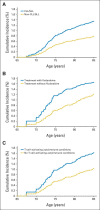Risk Factors for Melanoma Among Survivors of Non-Hodgkin Lymphoma
- PMID: 26240221
- PMCID: PMC4582142
- DOI: 10.1200/JCO.2014.60.2094
Risk Factors for Melanoma Among Survivors of Non-Hodgkin Lymphoma
Abstract
Purpose: Previous studies have reported that survivors of non-Hodgkin lymphoma (NHL) have an increased risk of developing cutaneous melanoma; however, risks associated with specific treatments and immune-related risk factors have not been quantified.
Patients and methods: We evaluated second melanoma risk among 44,870 1-year survivors of first primary NHL diagnosed at age 66 to 83 years from 1992 to 2009 and included in the Surveillance, Epidemiology, and End Results-Medicare database. Information on NHL treatments, autoimmune diseases, and infections was derived from Medicare claims.
Results: A total of 202 second melanoma cases occurred among survivors of NHL, including 91 after chronic lymphocytic leukemia/small lymphocytic lymphoma (CLL/SLL) and 111 after other NHL subtypes (cumulative incidence by age 85 years: CLL/SLL, 1.37%; other NHL subtypes, 0.78%). Melanoma risk after CLL/SLL was significantly increased among patients who received infused fludarabine-containing chemotherapy with or without rituximab (n=18: hazard ratio [HR], 1.92; 95% CI, 1.09 to 3.40; n=10: HR, 2.92; 95% CI, 1.42 to 6.01, respectively). Significantly elevated risks also were associated with T-cell activating autoimmune diseases diagnosed before CLL/SLL (n=36: HR, 2.27; 95% CI, 1.34 to 3.84) or after CLL/SLL (n=49: HR, 2.92; 95% CI, 1.66 to 5.12). In contrast, among patients with other NHL subtypes, melanoma risk was not associated with specific treatments or with T-cell/B-cell immune conditions. Generally, infections were not associated with melanoma risk, except for urinary tract infections (CLL/SLL), localized scleroderma, pneumonia, and gastrohepatic infections (other NHLs).
Conclusion: Our findings suggest immune perturbation may contribute to the development of melanoma after CLL/SLL. Increased vigilance is warranted among survivors of NHL to maximize opportunities for early detection of melanoma.
© 2015 by American Society of Clinical Oncology.
Conflict of interest statement
Authors' disclosures of potential conflicts of interest are found in the article online at www.jco.org. Author contributions are found at the end of this article.
Figures
References
-
- Howlader N, Noone A, Krapcho M, et al. SEER Cancer Statistics Review. Bethesda, MD: National Cancer Institute; 1975-2011. http://seer.cancer.gov/csr/1975_2011/
-
- Travis LB, Curtis RE, Hankey BF, et al. Second cancers in patients with chronic lymphocytic leukemia. J Natl Cancer Inst. 1992;84:1422–1427. - PubMed
-
- Goggins WB, Finkelstein DM, Tsao H. Evidence for an association between cutaneous melanoma and non-Hodgkin lymphoma. Cancer. 2001;91:874–880. - PubMed
Publication types
MeSH terms
LinkOut - more resources
Full Text Sources
Medical


